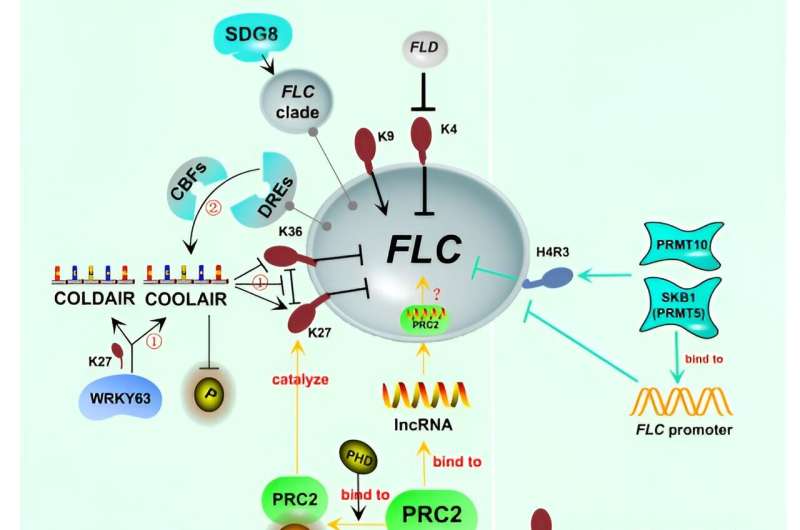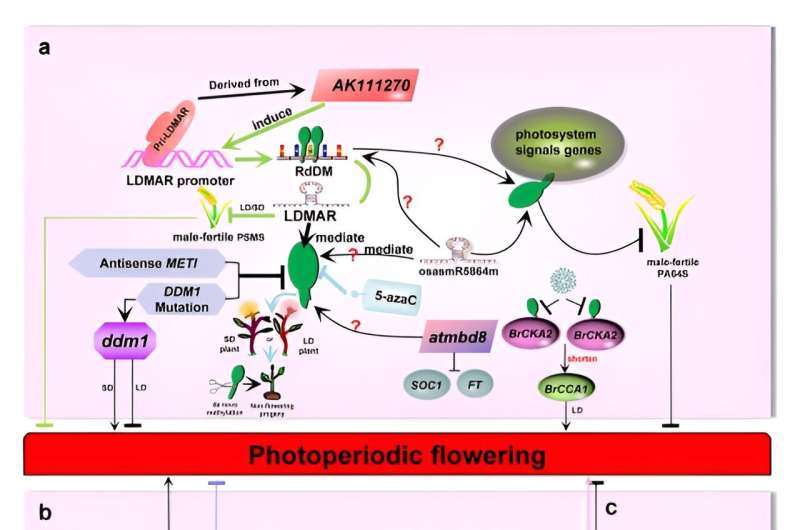This article has been reviewed according to Science X's editorial process and policies. Editors have highlighted the following attributes while ensuring the content's credibility:
fact-checked
trusted source
proofread
Examining the role of methylation in vernalization and the photoperiod pathway: A potential flowering regulator?

Recognized as a pivotal developmental transition, flowering marks the continuation of a plant's lifecycle. Flowering time determines the length of plant reproductive period and environmental adaptability. The correct flowering time is very significant for plants to reproduce fruit successfully and is controlled by environment and endogenous signals.
Vernalization and photoperiod are the two main flowering pathways orchestrating a large number of floral signals. Methylation is one of the most important epigenetic modifications, which is involved in many key plant growth and development events. Methylation, including histone methylation, DNA methylation and RNA methylation, has shown more and more potential regulatory roles in plant flowering in recent years.
However, it is reported that the summary of apparent regulatory factors involved in vernalization and photoperiod flowering is limited, and the regulatory pathways involved in a variety of internal and external signals are not clear.
Recently, the article "Role of methylation in vernalization and photoperiod pathway: a potential flowering regulator? " has been published in Horticulture Research.
This paper focuses on the complex molecular regulatory networks between flowering genes, methylation (methyltransferase/demethylase), lncRNAs, phytohormones and environmental signals (cold and light) in vernalization and photoperiod pathways.

First of all, this paper summarizes whether/how methylation acts to vernalization and photoperiod-induced flowering before and after the reactivation of FLOWERING LOCUS C (FLC, central flowering regulator), focusing on the apparent regulatory factors such as FLC, COOLAIR, PRC2, SKB1, BvRNMTa/b, BrCKA2 and BrCKB4.
Secondly, the molecular regulatory networks of methylation involved in both vernalization and photoperiod-induced flowering were demonstrated, and the heritability of methylation imprinting in vernalization and photoperiod pathways was summarized.
For the first time, this paper collects and overviews the limited evidence that RNA methylation regulates flowering in vernalization and photoperiod pathways, and illustrates the molecular regulatory networks in which it participates, which may provide some theoretical support and new perspective of observation for the follow-up study of RNA methylation.
Finally, based on pharmacology and molecular level, the paper discusses in detail whether and how methylation can replace vernalization/photoinduction to regulate flowering. Based on the existing empirical research, this paper puts forward for the first time the possibility of methylation reagents to (partly) replace vernalization and photoinduction as flowering regulators in the future, which may provide a new idea for the study of plant epigenetics in the field of development.
More information: Meimei Shi et al, Role of methylation in vernalization and photoperiod pathway: a potential flowering regulator?, Horticulture Research (2023). DOI: 10.1093/hr/uhad174
Provided by NanJing Agricultural University



















